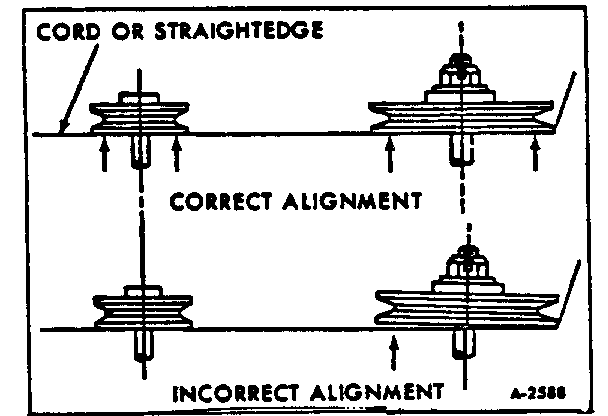ACCESSORY DRIVE BELT DIESEL PRE-DELIVERY RETENSIONING

VEHICLES AFFECTED: All 1982-1984 Models With a 6.2L Diesel Engine
THIS BULLETIN CANCELS AND SUPERSEDES PSB 6-163 (NOV. 15, 1983) ALL COPIES OF WHICH SHOULD BE DESTROYED.
Pre-delivery retensioning of drive belts on 6.2L diesel engines is MANDATORY to maintain proper adjustment of the belt.
A high percentage of belt tension may be lost during the first 15 minutes that the engine is run. This occurs when the initial stretching of the belt fibres relaxes as the belt seats itself in the pulleys. Vibrations unique to diesel engines, especially at idle, continue to stretch belt fibres throughout the life of the belt, although a majority of this occurs during the first 15 minutes of running time. Once a belt has accumulated 15 minutes running time, it is considered a used belt, and the parameters of belt tension change accordingly.
BELT TENSIONING
During the Dealer pre-delivery inspection, the belt tension must be checked. If the tension is below 350 N (80 pounds), the tension must be reset to 445 N (100 pounds).
It is recommended that when a vehicle is in for service and a new belt is installed that the belt be tensioned to the new belt specification (see attached chart). The engine should then be run for a minimum of 15 minutes at idle. The belt should be allowed to cool and the tension rechecked. If below 350 N (80 pounds), retension the belt to 445 N (100 pounds).
A used belt should never be tensioned to more than 445 N (100 pounds). When checking used belt tension, belt should feel only warm to the touch or cooler.
CAUTION:
Avoid over-or-under-tightening belts. Loose belts result in slippage which can lead to belt and pulley 'glazing' and inefficient component operation. Once a belt has become 'glazed', it will be necessary to replace the belt. Loose belts can also place high impact loads on driven component bearings due to the whipping action of a loose belt. Over tightened belts can lead to bearing damage and early belt failure.
When adjusting drive belts, use belt tension gauge J-23600-B placed at the centre of the greatest span. Use the following chart for belt tensioning.
BELT REPLACEMENT
The following belts are recommended for use with the 6.2L diesel engines:
Belt Usage Recommended Belt ---------- ---------------- Alternator *1982-84 14050449 (43 X .380 HiRide) A/C 1982-84 14033869 (60 X .380 HiRide) Power Steering 1982-84 14050459 (45 1/2 X .380 HiRide) *Alternator/Vacuum Pump 1984 (G, P-Models) 15592124 (49 X .380 HiRide) PULLEY INSPECTION ----------------- Examine the pulleys for chips, nicks, tool marks, cracks, bent sidewalls, rust, corrosion, or other damage.
Check the pulley alignment. Misaligned pulleys shorten belt life.
1. Place a straightedge or position a cord line across two pulleys so that they touch at all points (Figure.1).
2. Turn each pulley a half revolution and recheck with a straightedge or cord. Full contact at all points should still be made. If contact is not made at all points, the pulley may be warped or shaft bent. Replace any parts found to be damaged.
BELT INSTALLATION
Place the belts into the pulley grooves by hand. Do not force a belt into a pulley groove by prying with a screwdriver, crowbar, or other wedge type of tool. Prying a belt into position can damage both the belt and drive components.
Position the accessory or adjusting bracket and check the tension. Adjust as necessary according to the 'Belt Tension Chart'.
BELT TENSION CHART
IF BELOW: RETENSION TO: Newton (Pounds)* Newton (Pounds)*
DEALER
(Pre-delivery inspection) 350 (80) 45 (100)
SERVICE (New Belt) Set Tension to 775 N (175 pounds)
SERVICE (New belt after minimum of 15 minutes running time) 350 (80) 445 (100)
SERVICE (Used belt-any mileage over 80 KM/50 miles) 275 (60) 445 (100)
*Make checks and adjustments only after belts have been allowed to cool. A hot belt can give a false tension reading.
BELT INSPECTION
To carry their full load, drive belts must grip the entire area of contact with the pulley. When drive belts are worn, they should be replaced, as overtightening will not prevent silppage. DO NOT use belt dressings to extend belt life. Most dressings contain chemicals which tend to soften the belts. This softening process only temporarily increases the friction between the telt and pulley grooves.

General Motors bulletins are intended for use by professional technicians, not a "do-it-yourselfer". They are written to inform those technicians of conditions that may occur on some vehicles, or to provide information that could assist in the proper service of a vehicle. Properly trained technicians have the equipment, tools, safety instructions and know-how to do a job properly and safely. If a condition is described, do not assume that the bulletin applies to your vehicle, or that your vehicle will have that condition. See a General Motors dealer servicing your brand of General Motors vehicle for information on whether your vehicle may benefit from the information.
